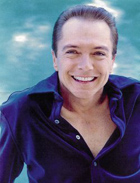
David Cassidy in the News
The ReGeneration Recycled TV, fashion and music meet boomers' longing for yesterday
August 20, 1993
By Patricia Rodriguez
Fort Worth Star-Telegram
Talk about back to the future. In the space of three days on three separate channels last month, it was possible to witness the following: "The Partridge Family," in full-color rerun. "The Partridge Family" again, this time introduced by a fortysomething David Cassidy, wearing a modified shag haircut and driving a psychedelic bus. And then the modern David Cassidy again, this time with a microphone instead of the bus, singing "I Think I Love You." Haven't we already been there, done that?
Yes. And that's the point. In music, movies, television and fashion, ours has become a culture of reruns.
In fashion, we're enmeshed in the '70s; in music, somewhere between the late '70s and early '80s; in movies and television, anywhere but the present.
Look no further than the local movie house.Opening recently were "The Fugitive" (based on the 1960s TV series) and "The Coneheads" (based on the 1970s "Saturday Night Live" skits).
Or the theater, where the "Real Live Brady Bunch" -- a bunch of actors re-creating actual episodes of the series -- has been the toast of New York and Chicago.
Or the music scene, where dinosaurs like Guess Who, the Gap Band and Aerosmith are back on the road, and disco retrospectives and early '80s new wave are a big part of the club scene.
Or fashion, where the clothes everybody said they'd never wear again -- bell-bottoms, clogs, platforms, midriff tops -- are cluttering the stores.
You know, a lot of these ideas weren't all that inspired to begin with. So why are we paying money to wear/watch/listen to them once again?
Blame the economy -- when things are sluggish, businesses prefer rehashing successes to trying bold new things. Blame the entertainment industry, always eager to jump on any bandwag on, in this case the remake trend.
But most of all, blame yourself.
"I think there's a lot of nostalgia involved in all that," says Alan Albarran, assistant professor of TV/radio at Southern Methodist University in Dallas. "It's that the baby boom generation has now grown up. Like the Addams Family; we hear that theme song, we still want to snap our fingers. The little cultural snippets like that shape our lives, and we still want to experience that."
Boomers in charge
That's particularly true of the younger boomers, who want to watch the stuff they grew up on and will pay to do so. But it's not only their spending habits that explain the run on reruns. Those ++ roughly between the ages of 29 and 35 are finally getting the corporate power to influence the creation of pop culture.
"When we were 15, people who had grown up on the '50s were running things, so they stuck things like 'Happy Days' and 'American Graffiti' on the air," says New York record executive and nostalgia buff Cliff Chenseld, 33. "Now the powers in pop culture are people who grew up in the '70s, and whether people want it or not, they're going to shove [the '70s] on people."
Which is exactly what he and his partner, Craig Balsam, 32, are doing. In early 1990, they founded the '70s Preservation Society to help sell their compilations of '70s music (available, in deference to modern technology, on CD and cassette, not eight-track or vinyl). They've made a tidy profit selling titles like "Disco Fever" and "Those Rocking '70s," including such classics as "You Light Up My Life" and "Disco Inferno."
"We were like, people our age are going to get nostalgic about their youth," Mr. Chenseld says. "And we also thought that younger people were going to start feeling like they missed something. You know, like people my age think we missed out on Woodstock."
And indeed, the retro fad is popular not only among those who remember it from the first time around.
The '70s fashions -- bell-bottoms, skinny rib-knit tops, exaggerated platform shoes -- are being worn by teens and young adults, not career women in their 30s and 40s who wore the originals, says New York fashion expert Lynn Schnurnberger.
"They weren't flattering the first time around. Why would we wear them again?" says Ms. Schnurnberger, who surveyed 40,000 years of fashion in her tongue-in-chic-cheek book, "Let There Be Clothes." "But to younger [kids], all of this stuff is new."
Nickelodeon finds niche
Children's cable network Nickelodeon has carved a viewing niche by alternating new programming with such vintage shows as "Flipper," "Dennis the Menace" and "Yogi Bear." In the evenings, its "Nick at Nite" programming targets nostalgic adults with reruns of "Dick Van Dyke," "F-Troop," "Get Smart" and others.
But old fans aren't the only ones watching.
"You can walk into a college class today and start talking about 'Leave it to Beaver,' and they know exactly what you're talking about," says Mr. Albarran. "And all of them were born well after that show was over."
Chalk it up to the magic of television. Thanks to syndicated reruns and the ever-increasing programming demands of the expanding cable systems, some popular shows never left the air after their cancellation.
